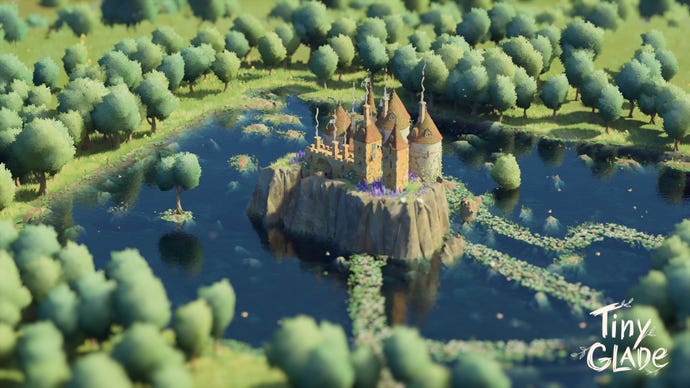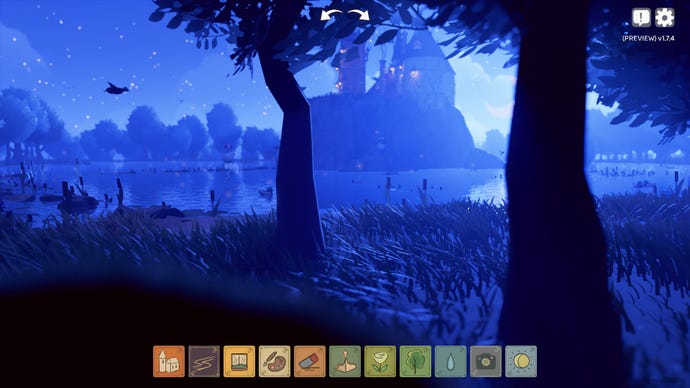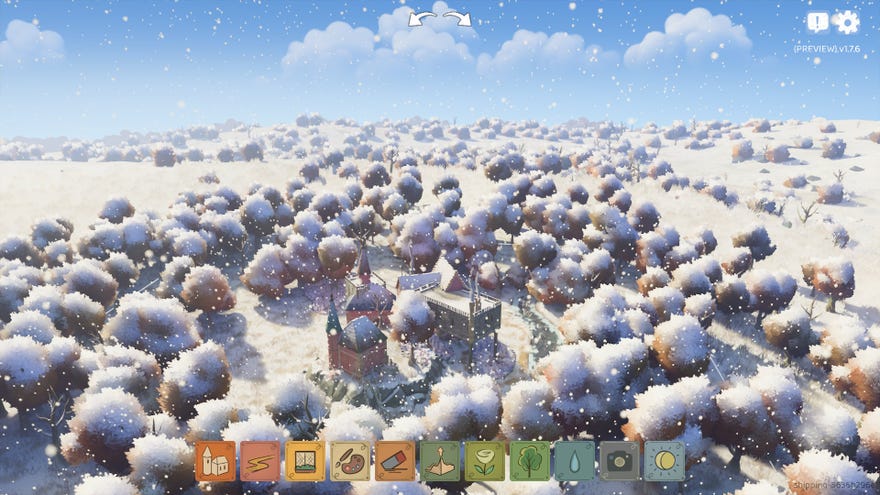Tiny Glade has been a constant presence on TikTok for the last year or so. It's never far away. In between burrito recipes and hymns to the Fujifilm X100v, this gorgeous toylike art tool's gamely turning stretches of balmy meadow into semi-ruined castles, semi-ruined villages and semi-ruined citadels.
Dreamy and slightly haunted, it's conjured words like "bewitching" and "spellbinding" in the comments sections, too. It makes sense, really. Tiny Glade's a game about making rustic dioramas and then photographing them. It's not hard to imagine some exiled magical person might live in here among the rocks and reeds and wild heather.
It feels like we've been here before - sort of. Only recently (I just checked, it was March) I was gripped by Summerhouse, another toylike thingy about making beautiful, almost derelict buildings. Summerhouse remains a favourite, and I think Tiny Glade is right up there with it. But I also think that there's more than enough room for two of these thingies in such quick succession, particularly when they're so distinct, and when they delight and compel in such distinct ways.
 Image credit: Rock Paper Shotgun/Pounce Light
Image credit: Rock Paper Shotgun/Pounce Light
Tiny Glade's biggest difference is that it's 3D. You're given a snug patch of land, and you can move the camera around as you craft rounded towers and squat, angular buildings, and lay down walls and fences and paths. You can move the ground too, pulling rocks or even cliffs out of the earth or pushing the soil down to find rivers and lakes waiting there. Then you can move the camera in close, pull it way back, tilt it all around in your hunt for the most charming angle. You can even view what you've built from overhead, like some cozy Moholy-Nagy.
All of this brings me to a second big difference, and perhaps the most important one. Summerhouse was all about unlocking new elements: new windows and doors, AC units with cats sat on them, massive graffiti tags. Not only does Tiny Glade keep us firmly in that friendly historical period known as "yore", it doesn't give you constant showerings of new individual bits and pieces so much as it contextually twists the things that you already have based on how you use them. Plant a tower and you can then push and pull at it with the mouse to make it taller or shorter, fatter or thinner. Clip two panes of glass close together, and the game may turn them into a big arched window. Flatten the roof of a hall enough and the game interprets your will and swaps the roof out for crenellations. Run a path through a building and the game will obligingly add a door.
This stuff gets at the heart of what's special here, in fact. Tiny Glade, like all the best Grand Designs, reveals that architecture is always a bit of a negotiation. In this case, I place something, and then the game itself sometimes chooses how to decorate it. "Wouldn't a stack of wood look good by that wall", it seems to think. Then I move the wall a few inches and the game decides I've ruined everything and petulantly ditches the wood completely. But then it's instantly back with a new idea: "Maybe a lean-to might look nicer, instead?"


 Image credit: Rock Paper Shotgun/Pounce Light
Image credit: Rock Paper Shotgun/Pounce Light
So I make buildings and the game often makes little micro-adjustments and finesses in real-time. This is what gives Tiny Glade its lovely rattly, fidgety feel. Just stretching a wall across a field is a real moment of wonder here, because even as the wall arcs and curves and bows under my mouse pointer, the whole thing is constantly changing in other ways and forever readjusting to its new total length. Bricks pop in and out of place, stones crumble and uncrumble as the overall form I'm making morphs.
And that's just a wall. Scale it up to a tower and you've got a design tool that genuinely feels like it has playful gremlins rolling around inside it. Bodge a castle together and when you look back at what you've done, you might see loads of little things you didn't specifically add, but they're all so whimsical and trivial there's no doubt that you're still the author.
Oh, the playfulness. It's there in the seasons, which come in a broad range you can select from, including rosy autumns and golden summers. It's there in the way winter brings that oily sheen of fresh ice to rivers, and in the way that, if you remove land that the game had already placed a grazing sheep on, the sheep will get a little balloon or umbrella to keep it aloft and keep its feet out of the muck.
 Image credit: Rock Paper Shotgun/Pounce Light
Image credit: Rock Paper Shotgun/Pounce Light
But there's clarity, too. The tools are all easy to understand based on their icons at the bottom of the screen, and when there are options - building cladding, say, or different colours of stone - they pop out in sensible sub-menu radials and are easy to navigate. The camera mode is an absolute treat, too, allowing you to meddle with vignetting and aperture and not only choose a focal point but choose the size of the focal point. Moholy-Nagy would be impressed, I reckon. I've spent as long messing with the camera stuff as I have building silly little towns.
Coziness is a choice, though, and Tiny Glade initially reminded me of that old quote from Ford about the Model T - you know, the fact that the car came in any colour you wanted as long as it was black. For my first few hours I worried that Tiny Glade offered any vista as long as it was twee. But the more I play, the more I’m sure that’s not really true. My personal limits are tweeness, but I'm inclined to believe that’s me rather than the game. To put it another way, I can’t wait to see what real talent does with this lovely thing.
This review is based on a review build of the game provided by the publisher.

 4 weeks ago
22
4 weeks ago
22









 English (US) ·
English (US) ·